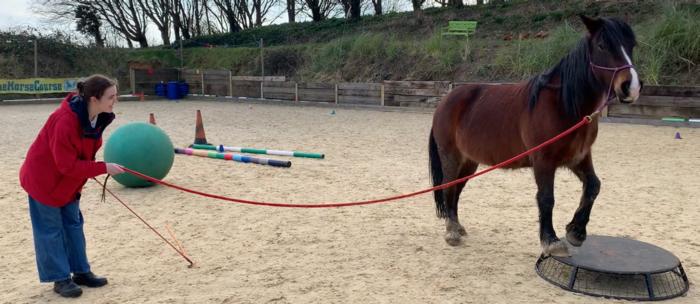In the evolving landscape of therapeutic technology, a pioneering study from the University of Bristol proposes a radical rethink of how interactive robots engage with users, especially those grappling with mental health challenges such as PTSD, trauma, and autism. The research draws inspiration from equine-assisted interventions (EAIs), which use horses as dynamic, responsive partners in therapy, with the potential to transform robotic design into something far more sophisticated than mere compliant companions.
Equine-assisted interventions have long been acknowledged for their effectiveness with individuals whose emotional expression and regulation are limited. Unlike traditional talking therapies, EAIs leverage the horse’s intrinsic sensitivity to human body language and emotional energy. Horses respond not to commands alone but to the emotional state of the person, subtly modulating their behavior in real-time. This bidirectional relationship acts as a ‘living mirror,’ encouraging participants to develop greater emotional awareness and self-regulation. The study posits that robots, too, can be engineered to exhibit this kind of autonomous, emotionally contingent behavior.
Current social robots typically follow rigid programming focused on obedience and predictability. They prioritize user comfort and compliance, often rendering interactions one-dimensional and superficial. The University of Bristol team challenges this orthodox approach, arguing that therapeutic robots should embody active partnership rather than passive companionship. To emulate the therapeutic qualities of EAIs, robots must exhibit a form of resistance or modulation contingent on the user’s emotional regulation, mirroring how horses withdraw or engage based on the emotional cues they perceive.
At the core of the study is a conceptual shift from command-following to emotional co-regulation. Researchers argue that robots should withhold interaction or respond differently when users display stress or agitation. This mechanism demands that users achieve a modicum of calm and emotional clarity to engage successfully with the robot, fostering skills in emotional self-awareness and regulation. Such dynamic responsiveness requires advances in the robot’s sensory and interpretive capacities, including sophisticated emotional sensing technologies, real-time movement adaptation, and context-aware machine learning algorithms.
Technically, designing robots capable of this level of emotional interaction involves integrating multimodal sensor systems that detect physiological signals—such as heart rate variability, skin conductance, and facial expression analysis—to infer user emotional states. These inputs would feed adaptive software models that can adjust robotic behavior seamlessly, creating an interactive loop akin to the nuanced human-animal engagements seen in EAIs. This integration heralds a promising frontier in human-robot interaction research, potentially extending beyond clinical contexts into education, workplace well-being, and social skills development.
Such therapeutic robots, infused with a dynamic and autonomous framework, would necessitate novel motion dynamics that are neither overly predictable nor erratic but are responsive in an intuitive and empathetic manner. Movement here is not merely functional but a form of communication—robots would employ micro-behaviors, pacing, and spatial adjustments to signal attunement or disengagement, paralleling the subtleties observed in equine responses.
Nevertheless, this innovative direction raises profound ethical questions. Foremost among them is whether robotic entities can replicate the profoundly affective and sentient qualities intrinsic to living animals. The therapeutic value of horses in EAIs is partly rooted in their sentience and unpredictability—a dimension that may resist full mechanization. The researchers suggest that ensuring emotional authenticity and ethical soundness in robot-mediated therapy will depend on balancing technological advances with careful consideration of user experience and expectations.
The implications of bridging emotional mirroring between humans and robots could revolutionize therapeutic paradigms. Unlike static, programmed machines, robots embodying these principles would help users not only cope with but actively work through their emotional dysfunctions by fostering self-regulatory feedback loops. This could reduce reliance on scarce animal-facilitated interventions, making therapy more accessible and scalable while preserving the critical element of emotional co-regulation.
Future research pathways highlighted by the study emphasize the importance of interdisciplinary collaboration. Areas such as affective computing, behavioral psychology, and robotics engineering must converge to refine sensors and algorithms that power these responsive robots. Moreover, longitudinal studies are essential to evaluate the therapeutic efficacy and psychological impact of interacting with emotionally autonomous robots over time, as well as their potential to build trust and empathy with human users.
In extending beyond therapy, the principles extracted from EAIs could inspire robots designed for stress management in professional environments, emotional coaching, and social skill training for populations with communication difficulties. The concept positions such robots not as substitutes but as collaborators in emotional development, requiring engagement codes that respect the user’s emotional state as a condition for interaction, thereby promoting healthier emotional habits.
At the technological frontier, advancing machine learning approaches capable of contextual emotional interpretation epitomizes one of the greatest challenges. Robots must not only recognize discrete emotional cues but interpret complex, evolving emotional landscapes and adjust their behavior dynamically without human intervention. This demands sophisticated pattern recognition, real-time decision-making, and nuanced motor responses coded within adaptive frameworks shaped by continuous interaction data.
The University of Bristol study, led by Ellen Weir and colleagues, thus offers a compelling vision for the future of therapeutic robotics. By learning from the organic and empathetic nature of equine therapy, it opens a pathway for designing robotic partners that are not only tools for comfort but active facilitators of emotional growth. This redefines the possibilities of human-robot interaction and sets ambitious goals for the ethical and technological design of future robotic companions.
Subject of Research: Animals
Article Title: ‘”You Can Fool Me, You Can’t Fool Her!”: Autoethnographic Insights from Equine-Assisted Interventions to Inform Therapeutic Robot Design’
News Publication Date: 28-May-2025
Web References: https://research-information.bris.ac.uk/en/persons/ellen-weir
Image Credits: Ellen Weir
Keywords: Computer modeling




